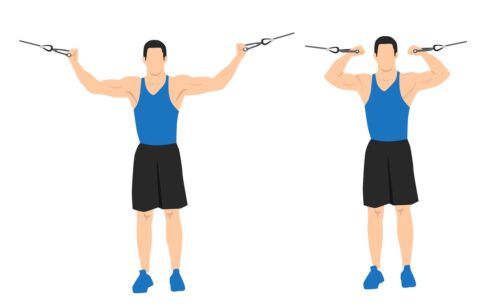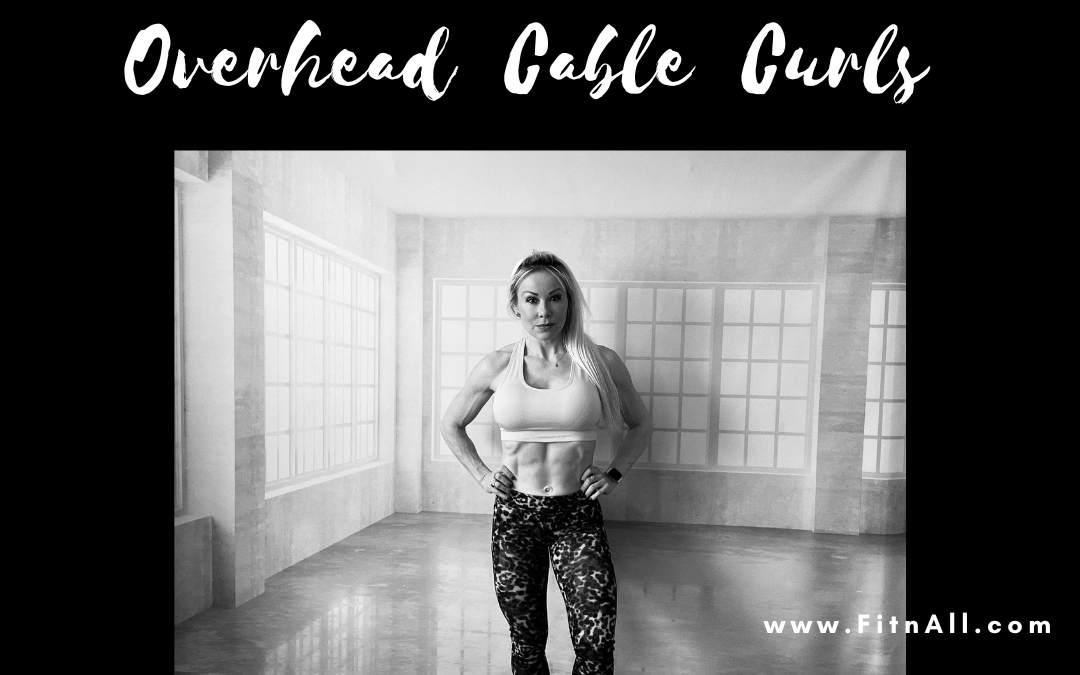One of the body parts that society has associated with a strong physique is the arm! I am specifically referring to the bicep, the muscle in the frontal part of the upper arm. A wonderful exercise that targets the bicep is the overhead cable curl.
Below we’ll look deeper into overhead cable curls and we’ll cover the following:
- Muscles involved in overhead cable curls
- Benefits associated with overhead cable curls
- How to properly do the overhead cable curl
- Common mistakes when performing overhead cable curls
- Bicep exercises to complete your bicep workout
- Video on how to do overhead cable curls
What Muscles Do Overhead Cable Curls Work?
Primary muscles involved in overhead cable curls:
- Biceps: We can also call this exercise the overhead biceps cable curl, the biceps brachii is the large muscle that lies on the anterior part of the upper arm between the shoulder and the elbow. It arises on the scapula and runs towards the upper forearm. The biceps muscle has two heads (the short head and the long head) – therefore its name. The biceps’ main function is to flex and supinates the elbow -allowing it to rotate so the palm faces up or forward. When the biceps contract, they pull up the forearm is pulled up.
Secondary muscles engaged:
- Brachialis: The brachialis muscle sits under the biceps brachii. This long muscle flexes your elbow. It connects your upper arm bone (humerus) to the long forearm bone (ulna).
- Brachioradialis: This muscle also sits in the anterior compartment of the upper arm. The brachioradialis muscle assists the brachialis with elbow flexion and connects your humerus bone to the short lower arm bone known as the radius.
- Wrist Extensors: These muscles are located along the forearm. They connect the upper arm bone (humerus) to your hand via your wrist and are involved in extending the wrists and fingers. Some of the wrist extensor muscles are the capri ulnaris, the digiti minimi, the digitorum, the indices, the pollicis brevis, and the retinaculum of the hand.
- Wrist Flexors: These muscles are also located along the forearm and connect your elbow to your hand. The wrist flexor muscles serve to flex the wrists and fingers. Your carpi radialis and carpi ulnaris flex your wrist up towards your forearm while you digitorum profundus and superficialis flexor muscles connect your forearm bone to the bones in your fingers, allowing them to curl.
- Deltoids: These muscles make up your shoulders. The wide part of the muscles attaches to your shoulder blade (scapula) and your collarbone (clavicle) before stretching down to your humerus bone. The anterior deltoid flexes and medially rotates the arm, the lateral deltoid abducts the arm, and the posterior deltoid extends and laterally rotates the arms.
Overhead Cable Curls’ Benefits
- Full Range of Motion: A great benefit of overhead cable curls is that they fully stretch the biceps, allowing a bigger range of motion.
- Hypertrophy: Overhead biceps cable curls help increase bicep size.
- Strength and Endurance: Overhead cable curls apply constant resistance on the eccentric and concentric portions of the movement, engaging your biceps for longer periods. This increases muscle endurance and bicep strength.
- Isolation: The Overhead cable curl is a single-joint movement, making it great to isolate the biceps.
- Proper Form: The position of your arms along with the tension from the cable make it hard to cheat while performing the movement.
- Safety: Having the arms stretched out and having constant tension from the cables allows for a more controlled movement, keeping your wrists and elbows safe.
- Aesthetics: Overhead cable curls help develop beautiful arms, which can translate into a great upper body.
- Simplicity: The overhead biceps cable curl is a straightforward and simple movement. All you need is a cable machine. However, you can also perform the exercise with resistance bands.
How to Do Overhead Cable Curls

- Adjust the height of the pulleys on each side of the cable machine to a height higher than that of your shoulders.
- Set a weight that is comfortable on each side of the pulley machine. This is an isolation exercise so you can even benefit when using light to moderate weight.
- Stand in the middle with your body evenly aligned and grab the handles with your palms facing towards the ceiling. Position your feet shoulder-width apart (or in a staggered stance) and make sure that your arms are fully extended and parallel to the floor. This is the starting position.
- As you exhale, slowly flex and squeeze your biceps on each side until your forearms and biceps touch.
- Hold at the top of the movement for a second or two.
- As you inhale, move your forearms back to the starting position.
- Repeat the movement for 8 to 12-15 repetitions and for 3 sets.
- You can work both arms simultaneously, one arm at a time, or alternating arms. Using one handle at a time to lift more weight or when the cables are too close together and you can’t totally extend your arms out.
Avoid Overhead Cable Curls Mistakes
Now that we know how to perform overhead cable curls, let’s see what the most common mistakes associated with the exercise are:
- Moving the arms back and forth: Do not move your elbows and upper arms throughout the movement. Aim to maintain the arms steady and your entire body stationary.
- Rounding your back: Keep your back straight and engage your core. A straight back helps you maintain proper alignment and perform the exercise properly.
- Moving the weights fast: Don’t perform the movement fast to avoid momentum, move the weights in a controlled way. Slow down the repetition timing and squeeze every rep to isolate your biceps.
- Using very heavy weights: Do not use very heavy weights in order to avoid that other muscles, such as the chest or back, help carry the load instead of the biceps. Lighter loads allow you to perform controlled reps with good form.
- Doing short reps: Aim to perform full reps. Be sure not to bring the arm just halfway in or halfway out.
Overhead Biceps Cable Curl Video
Bicep Workout
You can complete your bicep workout by performing the following exercises:
As you can see the overhead cable curl is a wonderful bicep exercise. It offers tremendous benefits associated with hypertrophy, strength, endurance, and aesthetics. Now that you know how to properly perform overhead cable curls, you can avoid the most common mistakes and enjoy their benefits. Remember, whether you want to lose weight, tone your body, or gain strength or size, all muscles must be trained.
Lift, Burn more Fat, Get Stronger and Live Healthier!
To a Fitter Healthier You,
The Fitness Wellness Mentor



